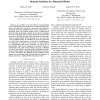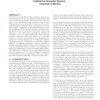119 search results - page 10 / 24 » Detecting Emotions from Connected Action Sequences |
RECOMB
2003
Springer
14 years 8 months ago
2003
Springer
Protein sequence alignments are more reliable the shorter the evolutionary distance. Here, we align distantly related proteins using many closely spaced intermediate sequences as ...
AIHC
2007
Springer
14 years 2 months ago
2007
Springer
This work addresses the problem of human action recognition by introducing a representation of a human action as a collection of short trajectories that are extracted in areas of ...
IROS
2007
IEEE
14 years 2 months ago
2007
IEEE
— In an effort to ease the burden of programming motor commands for humanoid robots, a computer vision technique is developed for converting a monocular video sequence of human p...
SIGMOD
2004
ACM
14 years 8 months ago
2004
ACM
The detection of correlations between different features in a set of feature vectors is a very important data mining task because correlation indicates a dependency between the fe...
AAAI
1993
13 years 9 months ago
1993
In planning tasks an agent may often find himself in a situation demanding that he choose an action that would prevent some unwanted event from occurring. Similarly, in tasks invo...


